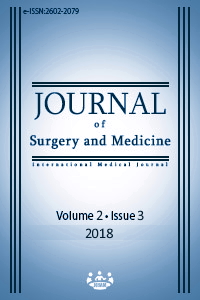General surgery service with limited feasibility in a rural hospital; Retrospective cohort study
Keywords:
Rural hospital, Surgery service, CohortAbstract
Downloads
References
Lehmann U, Dieleman M, Martineau T. Staffing remote rural areas in middle- and low-income countries: a literature review of attraction and retention. BMC Health Serv Res. 2008;8:19.
Dolea C, Stormont L, Braichet J. Evaluated strategies to increase attraction and retention of health workers in remote and rural areas. Bull World Health Organ. 2010;88(5):379-85.
Chankova S, Muchiri S, Kombe G. Health workforce attrition in the public sector in Kenya: a look at the reasons. Hum Resour Health. 2009;7:58.
Appiagyei A, Kiriinya RN, Gross JM, Wambua DN, Oywer EO, Kamenju AK, et al. Informing the scale-up of Kenya’s nursing workforce: a mixed methods study of factors affecting pre-service training capacity and production. Hum Resour Health. 2014;12(47):1-10.
World Health Organization. Increasing access to health workers in remote and rural areas through improved retention: Global Policy Recommendations. 2010 Accessed April 22 2015
Serneels P, Montalvo JG, Pettersson G, Lievens T, Butera JD, Kidanu A. Who wants to work in a rural health post? The role of intrinsic motivation, rural background and faith-based institutions in Ethiopia and Rwanda. Bull World Health Organ. 2010 May;88(5):342-9.
Binagwaho A, Kyamanywa P, Farmer PE, Nuthulaganti T, Umubyeyi B, Nyemazi JP et al. The Human Resources for Health Program in Rwanda – A New Partnership. The New England Journal of Medicine. 2013;369(21):2054-9.
Buchan J. Reviewing the benefits of health workforce stability. Human Resources for Health. 2010;8:29.
Basak F. Addition of a general surgeon without addition of appropriate support is inadequate to improve outcomes of trauma patients in a rural setting: a cohort study of 1962 consecutive patients. Eur J Trauma Emerg Surg. 2017 Dec;43(6):835-9.
Thompson MJ, Lynge DC, Larson EH, Tachawachira P, Hart LG. Characterizing the general surgery workforce in rural America. Arch Surg. 2005;140:74-9.
Zuckerman R, Doty B, Gold M, Bordley J, Dietz P, Jenkins P, Heneghan S. General surgery programs in small rural New York State hospitals: A pilot survey of hospital administrators. J Rural Health 2006;22:339-42.
Kwakwa F, Jonasson O. The general surgery workforce. Am J Surg. 1997;173:59-62.
Jonasson O, Kwakwa F, Sheldon GF. Calculating the workforce in general surgery. JAMA. 1995;274:731-4.
Ritchie WP, Rhodes RS, Biester TW. Workloads and practice patterns of general surgeons in the United States, 1995-1997: A report from the American Board of Surgery. Ann Surg. 1999;230:533-43.
Landercasper J, Bintz M, Cogbil TH, Bierman SL, Buan RR, Callaghan JP, et al. Spectrum of general surgery in rural America. Arch Surg. 1997;132:494-7.
Accreditation Council for Graduate Medical Education. Residency Review Committee for Surgery Case Log Statistical Reports. Available at: http://www.acgme.org/residentdatacollection/documentation/statistical_reports.asp. Accessed on August 20, 2007.
Wurie HR, Samai M and Witter S. Retention of health workers in rural Sierra Leone: findings from life histories. Hum Resour Health. 2016;14(3):1-15.
Brooks RG, Walsh M, Mardon RE, Lewis M, Clawson A. The roles of nature and nurture in the recruitment and retention of primary care physicians in rural areas: A review of the literature. Acad Med. 2002;77:790-8.
Öksüz A, Atadağ Y, Aydın A, Kaya D. The frequency of analgesic drug use in 65 years and above diseases and their causes; an experience of family medicine unit. J Surg Med. 2017;1(1):12-4.
Aydın A, Atadağ Y, Kaya D, Köşker HD, Başak F, Uçak S. Aile Hekimliği Uygulamasının Bir Eğitim ve Araştırma Hastanesine Ayaktan Hasta Başvurularındaki Etkisi.. Arch Clin Exp Med. 2017;2(3):74-8. 21. American Hospital Association and The Lewin Group. Challenges facing rural hospitals. Trend Watch. 2002;4:1.
Downloads
- 1546 1856
Published
Issue
Section
How to Cite
License
Copyright (c) 2018 Fatih Başak
This work is licensed under a Creative Commons Attribution-NonCommercial-NoDerivatives 4.0 International License.















